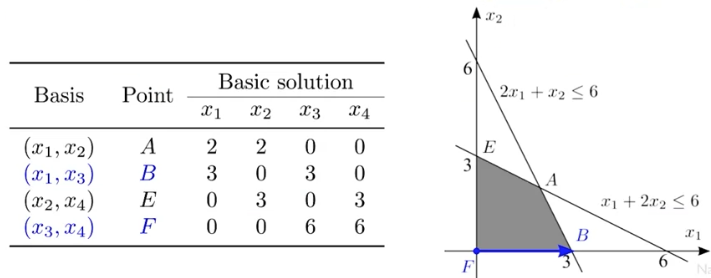Row and Column Views for a Linear System

例如对于如上等式组:
- Row view: 求三个面的交点
- Coluimn view: 三向量的合成向量 $x_1u+x_2v+x_3w=y$
Singular Cases: 等式组有无穷解或无解
- Row view: 三个面相较于一条线(无穷解); 双面平行、三面交三线、三面平行(无解)

- Column view: 三个向量只能形成一个平面或一条线,这样目标点其内有无数解,在其外则无解
Gaussian Elimination to solve Ax=b
高斯消元法:
- Elimination: 第 2-n 行减去第1行的倍数使得第 2-n 行的首元素为0,第 3-n 行减去第2行的倍数使得第 3-n 行的第二个元素为0…直至变成一个上三角矩阵
- Back Substitution: 从第n行开始消到第1行, 直至变成一个对角矩阵
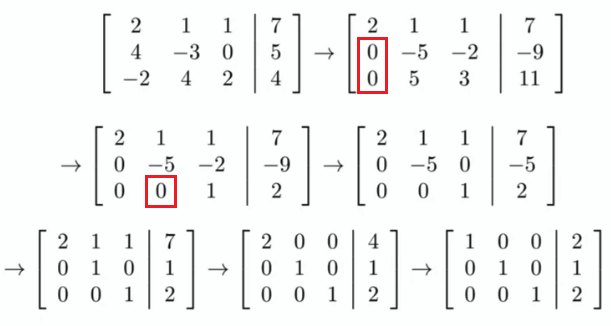
Time Complexity: $O(n^3)$
- Elimination: 对第一行的 elimination,剩下的 n-1 行都需要做 n+1 次操作(包括等号右侧的元素),因此共 (n+1)(n-1) 步;对第二行的 elimination, 共 (n)(n-2) 步… 总共 $n^3/3+n^2/2-5n/6\to n^3/3$ 步
- Back Substitution: 总共 $n^2/2$
Gauss-Jordan Elimination to find A^(-1)
该方法求逆矩阵的步骤与高斯消元法非常类似: \([\;A\;\vert\;I\;]\to[\;I\;\vert\;A^{-1}\;]\)
时间复杂度也同样是 $O(n^3)$
Linear Dependence and Independence
m 个 n 维向量 $x_1,…,x_m$ are linearly dependent 如果存在一个向量 $m\in\R^m$ \(w_1x_1+...+w_mx_m=0\)
使用高斯消元来判断 if dependent: 例如对于以下三个三维向量
- 如果高斯消元后仍存在三个 pivots 则这三个向量 linearly independent
- 反之如果 pivot 的个数小于三个,则 linearly dependent
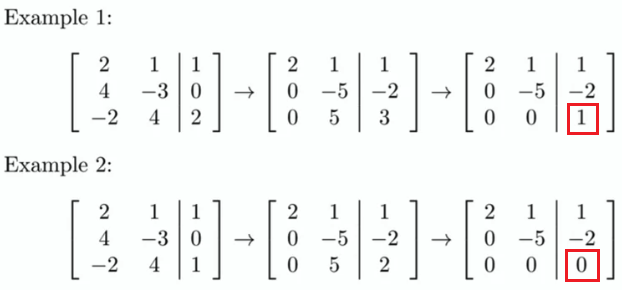
Standard Form of LP
Definition 1 (Extreme Points)
In an area set $A\in\R^n$, a point $x$ is an extreme point 如果不存在 $x_1,x_2\in A$, $\lambda\in\R$ 满足 $x=\lambda x_1+(1-\lambda)x_2$. 例如下图中黑色顶点以及半圆形的整条弧 
Proposition 1 For any LP, if there is an optimal solution, there is an extreme point optimal solution 反之不成立,也不意味着一个 optimal solution 一定是个 extreme point
Definition 2 (Standard Form of LP)
An LP is in the standard form if:
- all RHS (right hand side) values >= 0
- all variables >= 0
- all constraints are equalities
Requirement 1: all RHS >= 0 \(2x_1+3x_2\leq -4\implies -2x_1-3x_3\geq 4\)
Requirement 2: all variables >= 0
- if $x_i$ is nonpositive, replace it by $-x_i$ \(2x_1+3x_2\leq4,x_1\leq0\implies -2x_1+3x_2\leq4,x_1\geq0\)
- if $x_i$ is free, replace it by $x’_i-x’‘_i$ where $x’_i,x’‘_i\geq 0$ \(2x_1+3x_2\leq4\implies 2x'_1-2x''_1+3x_2\leq4,x'_1,x''_1\geq0\)
Requirement 3: all constraints are equalities
- For $\leq$, add a slack variable \(2x_1+3x_2\leq4\implies 2x_1+3x_2+x_3=4,x_3\geq0\)
- FOr $\geq$, minus a surplus variable \(2x_1+3x_2\geq4\implies 2x_1+3x_2-x_3=4,x_3\geq0\)
Example: 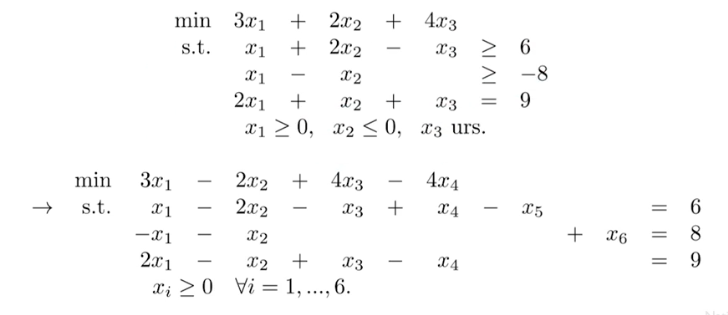
Standard Form of LPs in Matrices
\(\min\;\;c^Tx\)
\[\text{s.t.}\;\;\begin{aligned} Ax=b\\ x\geq0 \end{aligned}\]where $x_{n\times 1}$ is the variable
- $A_{m\times n}$ is the coefficient matrix
- $b_{m\times 1}$ is the RHS vector
- $c_{n\times 1}$ is the objective vector
Definition 3 (Basic solution)
Consider a standard form LP with $m$ constraints and $n$ variables. Assume $A$ has $m$ pivots, i.e., all rows of $A$ are independent
这意味着 $m\leq n$。又因为当 $m=n$ 时 A 为方阵,此时只有唯一解 $x=A^{-1}b$。因此不妨直接假设 $m\leq n$
Definition 3 (Basic solution) A basic solution to a standard form of LP must (1) has $n-m$ variables = 0 (2) satisfy $Ax=b$
Denotations:
- $x_N\in\R^{n-m}:n-m$ variables chosen to = 0 are nonbasic variables
- $x_B\in\R^m:$ remaining $m$ varaibles are basic variables
- the set of basic variables is called a basis
- $A_B:$ a nonsigular(invertible) $m\times m$ matrix formed by $m$ columns of $A$
therefore, we have $x_N=0$ and $x_B=A_B^{-1}b$
由于一个 basis 由 $n$ 个 variables 中的 $m$ 个组成,因此至多有 $\begin{pmatrix} n
m \end{pmatrix}$ 个不同的 bases
Example:
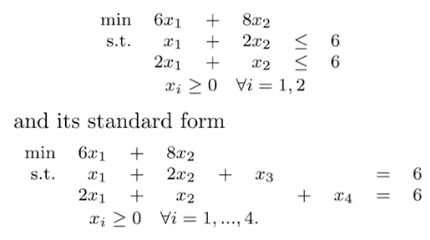

Definition 4 (Basic Feasible Solutions)
基于 basic solutions, basic feasible solutions 还需要满足所有 varaibles >= 0 (Definition 2-Requirement 1)。例如上图中的第三、四个 basic solutions 就不是 basic feasible solutions
Theorem 1 (Extreme Points and Basic Feasible Solutions) For a standard form LP, a solution is an extreme point of the feasible region $\iff$ it’s a BFS to the LP
Theorem 2 (Optimality of Basic Feasible Solutions) For a standard form LP, if there is an optimal solution, there is an optimal BFS
One-to-one mapping between BFS and extreme points: 其中 $x_1,x_2$ 体现各 solution 的实际坐标,$x_3,x_4$ 为 slack variables 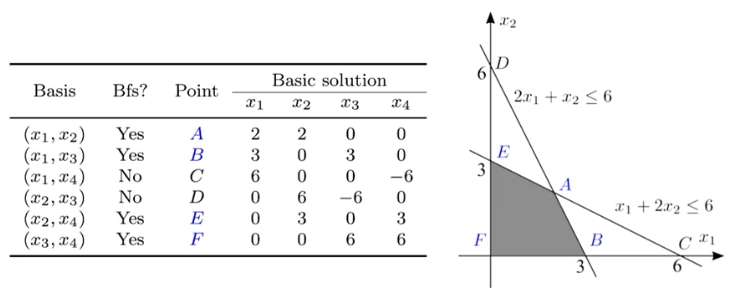
Definition 5 (Adjacent BFS)
从图形化的角度看,通过遍历所有 extreme points 即可找到 optimal solution. 但是对于算法而言遍历图形化的点是非常复杂的,因此 we search among all BFS instead of extreme points
那么如何 search among all BFS? 从任一 bfs 出发,keep moving to find a better adjacent BFS
Definition 5 (Adjacent BFS) Two bases are adjacent if exactly one of their variables is different Two BFS are adjacent if their associated bases are adjacent 体现在下图中,一对 adjacent BFS 对应一对 extreme points(在同一条边上);而从一个 BFS 移动到其任一 adjacent BFS 相当于在域的边上移动
The Simplex Method
进一步的,我们现在的目标是通过不断的 move to a better adjacent BFS 直至找到 optimal solution. 这一过程中有两个关键:
- 首先是判断 How to move to an adjacent BFS
- 其次是判断 Where to move(e.g. which adjacent is better) 以及 When to stop
How to move
核心是 Entering and Leaving,以上图中的移动 $F\to B$ 为例:
- 对于 $B$ 点: $x_1,x_3$ 为 basis(basic variables), 而 $x_2,x_4$ 为 nonbasic variables
- Entering: 选择一个 nonbasic variable, $x_4$, to become basic, 也就是把 $x_4$ 的数值从零涨到一个正数
- Leaving: 当 $x_4$ 上涨时,为了满足 $Ax=b$,某些原来的 basic variables 会下降。这里我们选择那个最先下降到零的 basic variable, $x_1$, to become nonbasic
Where to move
MAX objective function:
Example (1)
\[\max\;\;2x_1+3x_2\] \[\text{s.t.}\;\;\begin{aligned} x_1+2x_2&\leq6\\ 2x_1+x_2&\leq8\\ x_1,x_2&\geq0 \end{aligned}\]为 objective function 引入 $z$,为两个 constraints 引入 $x_3,x_4$ \(\max\;\;z\)
\[\text{s.t.}\;\;\begin{aligned} z\;\;\;-\;\;\;&2x_1&-\;\;\;\;&3x_2 & & & & &=0\\ &x_1 &+ \;\;\;\;&2x_2 &+ \;\;\;&x_3 & & &= 6\\ &2x_1 &+ \;\;\;\;&x_2 & & &+ \;\;\;&x_4 &=8\\ \end{aligned}\](1) Start from a BFS 这题的 starting BFS 非常明显,直接选择 $(x_3,x_4)$, 转化成 Tablua Form 如下:
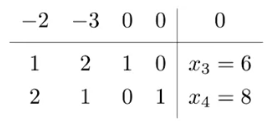
The first BFS is $x^{(1)}=(0 ,0,6,8)$ with $z^{(1)}=0$
(2) Entering and Leaving 现在有两个系数为负的 nonbasic variables $x_1,x_3$
(2.1) Which to enter? 首先我们的 objective function 为 MAX,因此我们需要 enter 一个系数为负数的 nonbasic variables. $x_1,x_2$ 的系数均为负数,那就任意选一个,assume choose $x_1$ to enter
(2.2) Which to leave? 在 $x_1$ enter 后,两个 constraints 变成了: \(\begin{cases} x_1 + x_3&=6\\ 2x_1 + x_4&=8 \end{cases}\)
此时当 $x_1$ 逐渐从零开始变大,$x_4$ 会更早低变成零(become nonbasic),先于 $x_3$. 因此 leave $x_4$
(3) Update Tabula 因为选择 enter $x_1$ leave $x_4$ 因此 pivot 行就是 $x_4$ 对应的的第二行,pivot 元素就是该行对应 $x_1$ 的第一个元素 
首先把 pivot 元素变成 1,然后将其他行的对应元素消除,完成后效果如下:
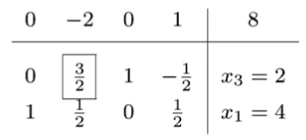
The second BFS is $x^{(2)}=(4,0,2,0)$ with $z^{(2)}=8$
(4) Repeat (2) & (3) 第一次更新完后两个 nonbasic varaibles $x_2,x_4$ 的系数一正一负
因为是 MAX 问题,一次选择负系数的 $x_2$ enter. 此时两个 constraints 变成了: \(\begin{cases} \frac{3}{2}x_2 + x_3&=6\\ 2x_1 + \frac{1}{2}x_2&=8 \end{cases}\)
因为 $8/(\frac{1}{2})>6/(\frac{2}{3})$,因此 $x_3$ 会更快地变零 $\to$ 选择 leave $x_3$
因为选择 enter $x_2$ leave $x_3$ 因此 pivot 行就是 $x_3$ 对应的的第一行,pivot 元素就是该行对应 $x_2$ 的第二个元素 
首先把 pivot 元素变成 1,然后将其他行的对应元素消除,完成后效果如下:
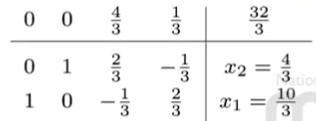
The third BFS is $x^{(3)}=(\frac{10}{3},\frac{4}{3},0,0)$ with $z^{(3)}=\frac{32}{3}$
(5) Stop and Find Optimal 第二次更新完后有两个系数为零的 basic variables $x_1,x_2$, 和两个系数为正的 nonbasic variables $x_3,x_4$。因为是 MAX 问题,系数为正的 nonbasic variable 在 enter 之后反而会使 objective function 下降,这意味着 stop moving & find the optimal solution
The optimal BFS is $x^{()}=(\frac{10}{3},\frac{4}{3},0,0)$ with $z^{()}=\frac{32}{3}$




Document Information
- Author: Zeka Lee
- Link: https://zhekaili.github.io/0005/03/01/linear-algebra/
- Copyright: 自由转载-非商用-非衍生-保持署名(创意共享3.0许可证)
